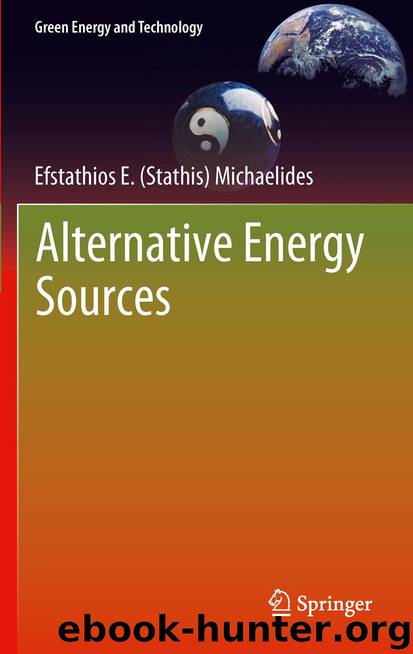Alternative Energy Sources by Efstathios E. (Stathis) Michaelides

Author:Efstathios E. (Stathis) Michaelides
Language: eng
Format: epub
Publisher: Springer Berlin Heidelberg, Berlin, Heidelberg
>10*1014
<0.3
0
0
0
The efficiency of a solar cell is defined as the ratio of the electric power it produces to the total insolation. It is apparent from this Table, that the reason for the low theoretical efficiency of semiconductor PV cells is the significant mismatch between the incident solar radiation and the capacity of the cell to convert the radiation to electricity. A “solar filter” that would convert the frequency of the entire solar radiation to an equal amount of energy with photons in the frequency range 4.29*1014 to 2.72*1014 Hz would be ideal. Such a filter would increase the theoretical conversion efficiency of photovoltaic solar cells to levels closer to 80%.
While crystalline silicon solar cells have been used for decades and have an excellent performance and reliability records, their production entails a great deal of energy input, because pure crystalline silicon requires a great deal of energy to be produced. Typically, the production of a PV cell requires four to five years of the energy it produces. This and the associated labor costs make photovoltaic energy appreciably more expensive than energy from conventional power units and are an impediment in the reduction of the production costs of silicon solar cells. More recent photovoltaic technologies have focused on the production of less expensive semiconductor materials regardless of the conversion efficiency. One such method is to deposit amorphous (e.g. non-crystalline) semiconductor materials, onto very thin film substrates of lower cost.
Thin film technology makes use of cadmium telluride (CdTe) or copper indium gallium selenide (CoInGaSe or CIGS), and amorphous silicon. The most recent designs of this technology strive to achieve the higher possible solar cell efficiency with thin films by using strategically chosen combinations of materials (multi-junction cells) and single materials (full spectrum cells) that respond to wider ranges of the available solar spectrum in a region, thereby producing more power. A second method is to concentrate on the technology for the production of less expensive solar cells by using more common and less pure materials, regardless of the efficiency that is achieved. For example, thin film polymeric solar cells have been produced with gallium arsenide as the doping. These cells have lower efficiencies (6–8%) but significantly lower production cost. Such low efficiencies are acceptable because the input energy, the insolation, is free of charge. For the more widespread use of energy from photovoltaics, the technology will have to concentrate mainly on two factors:a)Lower energy costs, which will have to be reduced to less than $0.1/kWh;
Download
This site does not store any files on its server. We only index and link to content provided by other sites. Please contact the content providers to delete copyright contents if any and email us, we'll remove relevant links or contents immediately.
| Alternative & Renewable | Drilling Procedures |
| Electric | Fossil Fuels |
| Mining | Nuclear |
| Power Systems |
Whiskies Galore by Ian Buxton(40329)
Introduction to Aircraft Design (Cambridge Aerospace Series) by John P. Fielding(32338)
Small Unmanned Fixed-wing Aircraft Design by Andrew J. Keane Andras Sobester James P. Scanlan & András Sóbester & James P. Scanlan(32141)
Craft Beer for the Homebrewer by Michael Agnew(17445)
Turbulence by E. J. Noyes(7037)
The Complete Stick Figure Physics Tutorials by Allen Sarah(6638)
Kaplan MCAT General Chemistry Review by Kaplan(6053)
The Thirst by Nesbo Jo(5785)
Bad Blood by John Carreyrou(5768)
Learning SQL by Alan Beaulieu(5410)
Weapons of Math Destruction by Cathy O'Neil(5036)
Man-made Catastrophes and Risk Information Concealment by Dmitry Chernov & Didier Sornette(4735)
iGen by Jean M. Twenge(4702)
Digital Minimalism by Cal Newport;(4540)
Life 3.0: Being Human in the Age of Artificial Intelligence by Tegmark Max(4507)
Audition by Ryu Murakami(4098)
1,001 ASVAB Practice Questions For Dummies by Powers Rod(4038)
Electronic Devices & Circuits by Jacob Millman & Christos C. Halkias(4027)
Pale Blue Dot by Carl Sagan(4001)
